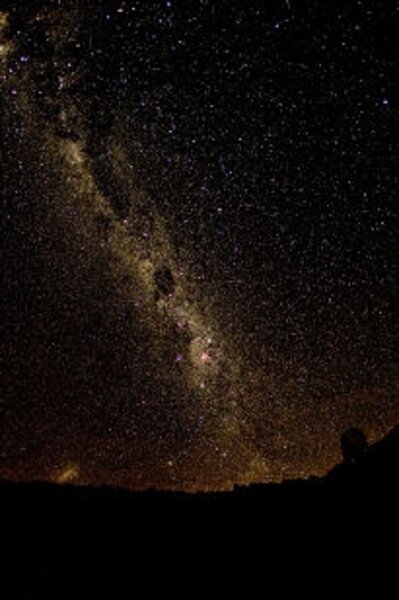Milky Way spins faster, has more heft than astronomers thought
Loading...
Watch out Andromeda; our heftier home galaxy is on a tear.
Astronomers have found that the Milky Way is spinning some 100,000 miles an hour faster than previous estimates indicated.
That means that the galaxy hosts 50 percent more mass than previously thought. And that means that when the Milky Way collides with the Andromeda galaxy some 2 billion to 3 billion years from now, it will be the clash of the Titans, not David versus, well, Andromeda.
(In case you're counting, that's about a billion years earlier than previous estimates. More mass also means a stronger gravitational tug pulling the two together.)
That is among the initial findings unveiled Jan. 5 from a team of astronomers trying to take the measure of the Milky Way. It's a long-term project to measure distances and motions within the Milky Way to very high precision.
Think of it as a case of trying to reconstruct the structure of a forest by measuring the trees.
As Karl Manten describes it, astronomers obviously have no trouble seeing whole galaxies outside our own. But we're too deep into the thick of things to see the full structure of the Milky Way. "We have to deduce its structure by measuring and mapping," says Dr. Manten, an astrophysicist at the Max Planck Institute for Radio Astronomy in Bonn and one of the members of the team.
The group is using a general approach that Lewis and Clark, even the Boy Scouts, would recognize. The tools, however? That's another matter altogether!
It's triangulation, still, no matter the scale
The general approach uses triangulation to measure the distance to the objects in question. They zero in on a target in the Milky Way – in this case, a maser – when the Earth is at one point on its trip around the sun. Then they look at the same object when Earth has traveled half-way around its orbit. The straight-line distance from the first point, through the sun, to the second point forms the base of the triangle. The object the group is viewing forms the triangle's apex.
Measurements of the length of the base and the angles to the object at each end of the baseline give the team enough information to calculate the distance to the object. By taking measurements of the same object year after year, the team also can determine the shape and speed of the object's orbit around the Milky Way's center.
And the measuring tools? Swap the theodolite or the Boy Scout Pathfinder compass for a cluster of enormous radio-telescopes known as the Very Long Baseline Array and you get the picture. The array consists of 10 upturned, dish-shaped radio antennas spread across the United States from Massachusetts and Puerto Rico to Hawaii.
The array can pick up radio signals as weak as the weakest signal captured by the largest dish in the network. But it can also spot details as fine as if the array were a single dish whose diameter ran from Massachusetts to Hawaii. And how precise is that? It's like having someone hold up a newspaper in L.A. and reading it from New York.
Target those masers
The team's targets are several masers, found in dense clouds where stars are forming. These regions are spread along the a rough line spanning from the edge of the Milky Way to near its core.
Some additional surprises: These star-forming regions are moving around the Milky Way's core more slowly than other regions. And they do so in elliptical orbits. And the Milky Way probably has four spiral arms, rather than just two.
Oddly, far more old stars appear in two of the four arms. The obvious question: Why? And the answer, if you've talked with many scientists, is equally obvious: We need more data! Team member Mark Reid, with the Harvard-Smithsonian Center for Astrophysics in Cambridge, Mass., announced the findings at the winter meeting of the American Astronomical Society, under way in Long Beach, Calif.





